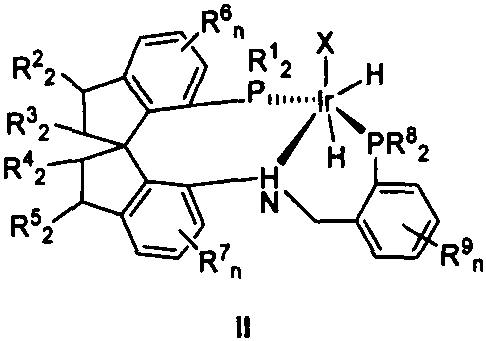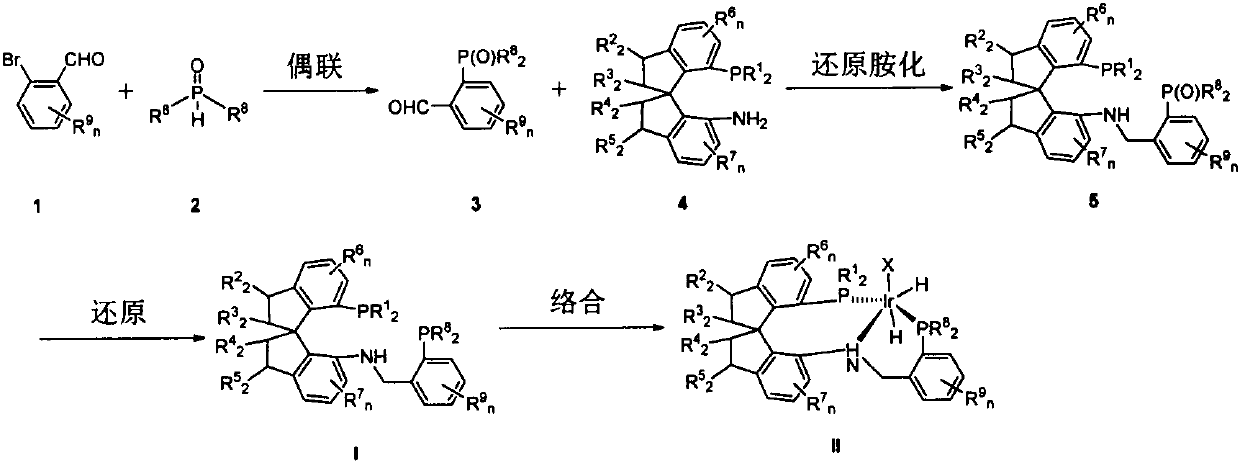Preparation methods and applications of chiral spirophosphine-nitrogen-phosphine tridentate ligand and iridium catalyst thereof
A catalyst and spiro ring technology, which is applied in the field of organic synthesis, can solve the problems such as the difficulty in recognizing the chirality of the carbonyl plane of the substrate by the catalyst, and achieve the effects of excellent enantioselectivity, mild reaction conditions and great practical value.
- Summary
- Abstract
- Description
- Claims
- Application Information
AI Technical Summary
Problems solved by technology
Method used
Image
Examples
Embodiment 1
[0038] The synthetic route of ligand Ia:
[0039]
[0040] In an argon atmosphere, weigh (R)-7′-bis-(3,5-di-tert-butylphenyl)phosphino-7′-amino-1,1′-spirodihydroindane 4a (300 mg, 0.46mmol) into a 100mL dry Schlenk tube, inject 12mL of anhydrous methanol into the syringe, and stir to dissolve. 2-Diphenylphosphinebenzaldehyde (176 mg, 0.61 mmol) and glacial acetic acid (42 μL) were added. The reaction was stirred at room temperature for 3 hours. Open the anti-port plug and pour NaBH at one time 3 CN (87mg, 1.38mmol), the reaction was carried out at 40°C for 15 hours. Cool to room temperature after the reaction, spin the system to dryness, add dichloromethane to dissolve, and quench with saturated sodium bicarbonate solution. Extract with dichloromethane, combine the organic phases, dry the organic phases with anhydrous magnesium sulfate, remove the desiccant by suction filtration, and remove the solvent from the filtrate with a rotary evaporator. The residue was subject...
Embodiment 2
[0052] The synthetic route of ligand Ib:
[0053]
[0054] Synthesis of intermediate 3a:
[0055] Weigh Pd(OAc) in a 25mL Schlenk tube 2 (56mg), dppp (103mg), 2a (310mg), replaced with argon, injected into degassed DMSO (4.0mL), stirred evenly, injected with o-bromobenzaldehyde (118μL) and diisopropylethylamine (248 μL), heated in an oil bath to 100°C for 20 hours. After the reaction, cool to room temperature, add 10 mL of ethyl acetate and 10 mL of water, extract with ethyl acetate, combine the organic phases, dry the organic phases with anhydrous magnesium sulfate, remove the desiccant by suction filtration, and remove the solvent from the filtrate with a rotary evaporator. The residue was subjected to silica gel column chromatography (petroleum ether: ethyl acetate = 5:1) to obtain 242 mg of white solid 3a with a yield of 66%.
[0056] Data for Intermediate 3a:
[0057] White solid, melting point 202-204°C.
[0058] 1 H NMR (400MHz, CDCl 3 )
[0059] δ10.74(s,...
Embodiment 3
[0091] The synthetic route of ligand Ic:
[0092]
[0093] Synthesis of Intermediate 3b:
[0094] Weigh Pd(OAc) in a 25mL Schlenk tube 2 (112mg), dppp (206mg), 2b (1026mg), replaced with argon, injected into degassed DMSO (8.0mL), stirred evenly, injected with o-bromobenzaldehyde (234μL) and diisopropylethylamine (496 μL), heated in an oil bath to 100°C for 20 hours. After the reaction, cool to room temperature, add 20 mL ethyl acetate and 20 mL water, extract with ethyl acetate, combine the organic phases, dry the organic phases with anhydrous magnesium sulfate, remove the desiccant by suction filtration, and remove the solvent from the filtrate with a rotary evaporator. The residue was subjected to silica gel column chromatography (petroleum ether: ethyl acetate = 5:1) to obtain 752 mg of white solid 3b with a yield of 71%.
[0095] Data for intermediate 3b:
[0096] White solid, melting point 58-60°C.
[0097] 1 H NMR (400MHz, CDCl 3 )
[0098] δ10.79(s, 1H), 8....
PUM
 Login to View More
Login to View More Abstract
Description
Claims
Application Information
 Login to View More
Login to View More - R&D
- Intellectual Property
- Life Sciences
- Materials
- Tech Scout
- Unparalleled Data Quality
- Higher Quality Content
- 60% Fewer Hallucinations
Browse by: Latest US Patents, China's latest patents, Technical Efficacy Thesaurus, Application Domain, Technology Topic, Popular Technical Reports.
© 2025 PatSnap. All rights reserved.Legal|Privacy policy|Modern Slavery Act Transparency Statement|Sitemap|About US| Contact US: help@patsnap.com



